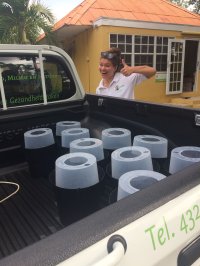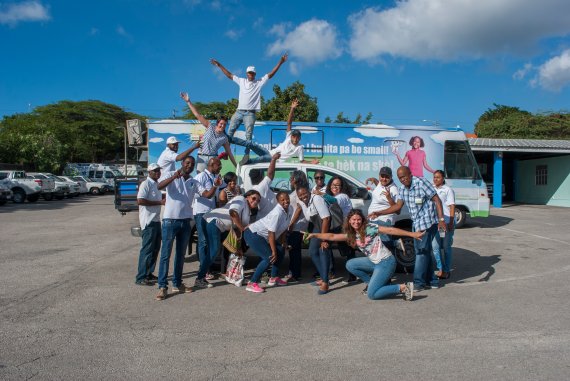‘I was out and about all the time, really. I drove all around the island in a pick-up, together with another intern and two locals. We first picked random places to take measurements, and then used Google Maps to try and find a house at that location. Only it was a challenge to then find the house we had chosen, because on Curaçao the houses are all jumbled up together. So you might get number 7 first with number 60 next, and then number 50. The occupants of the houses we went to were nearly always happy to collaborate. They invited us in, gave us a drink and started to tell us long stories about their children, for example. The fact that I could make contact like that with local people, who were often very enthusiastic and also spoke Dutch, was what I liked best about it.

Septic tank
I made a risk map for the yellow fever mosquito, Aedes aegypti. At the selected houses we first asked the occupants a few questions about risk factors for mosquitoes. We asked whether they had a septic tank, for instance, because certain mosquitoes can breed there. We then set a mosquito trap at each house. This was a kind of bucket of hay, which attracts the mosquitoes that want to lay eggs. It was lidded so the mosquitoes couldn’t fly out, and inside was a paper which the mosquitoes got stuck to when they flew up against it. After one week we collected the traps and counted the mosquitoes caught in them. We had to make sure the mosquito traps were covered so not too much rain got into them, and that they were in the shade so the water wouldn’t evaporate. It didn’t always work out well: some traps were destroyed by dogs. If that happened we would decide just to go on to the next house.

Rich and poor
You notice that rich and poor live quite segregated lives in Curaçao. There were neighbourhoods with a big gate and a guard, inside which everyone seemed to lead separate lives. In the poorer neighbourhoods, on the other hand, people did a lot more things together. We actually knocked on doors everywhere, even in the poorer parts where the police don’t go at night. By day that was usually perfectly OK. But sometimes the locals we were with would say, “No, this house is not good, we’ll go to the next one.” And then we listened to them because they know the place better than we do.’

